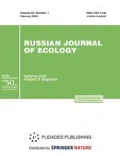Abstract
The most informative characteristics of the zooplankton-community response to the effect of industrial wastewater from mines have been determined using water bodies of the Kola Peninsula as an example. It has been demonstrated that qualitative and quantitative characteristics of zooplankton depend on the degree of industrial pollution of a water body and adequately reflect differences in the conditions of zooplankton growth between the whole water bodies and their individual parts. The role of zooplankton as an indicator has been assessed and the possibility of including it in the system of monitoring of water objects has been substantiated.
Similar content being viewed by others
REFERENCES
Aleksandrov, I.I., K faune bentosa kol'skikh ozer Bol'shogo i Malogo Vud''yavra (On the Benthic Fauna of Lakes Bol'shoi and Malyi Vud''yavr, Kola Peninsula), Kirovsk, 1930 (Archives of the Kola Research Center, Russ. Acad. Sci.).
Andronikova, I.N., Using the Structural and Functional Parameters of Zooplankton in the System of Monitoring, in Gidrobiologicheskoe issledovanie morskikh i presnykh vod (Hydrobiological Investigation of Sea and Fresh Waters), Leningrad: Nauka, 1988, p. 47.
Andronikova, I.N., Classification of Lakes by the Level of Biological Productivity, in Teoreticheskie voprosy klassifikatsii ozer (Theoretical Problems of Lake Classification), St. Petersburg: Nauka, 1993, p. 51.
Andronikova, I.N., Strukturno-funktsional'naya organizatsiya zooplanktona ozernykh ekosistem raznykh troficheskikh tipov (Structural and Functional Organization of Zooplankton in Lake Ecosystems of Different Trophic Types), St. Petersburg, 1996.
Balushkina, E.V. and Vinberg, G.G., The Relationship between Body Length and Weight in Planktonic Crustaceans, in Eksperimental'nye i polevye issledovaniya biologicheskikh osnov produktivnosti ozer (Experimental and Field Studies on Biological Bases of Lake Productivity), Leningrad, 1979, pp. 58-72.
Den'gina, R.S., Ekosistema ozera Imandra pod vliyaniem tekhnogennogo zagryazneniya (The Ecosystem of Lake Imandra under the Effect of Technogenic Pollution), Apatity: Kol'sk. Fil. Akad. Nauk SSSR, 1980.
Evdokimova, G.A., Changes in the Intensity of Microbiological Processes in Lake Imandra in Connection with Its Pollution, Prir. Khoz. Severa, 1988, issue 16, p. 59.
Fedorov, V.D., Kondrik, E.K., and Levich, A.P., Rank Distribution of Phytoplankton in the White Sea, Dokl. Akad. Nauk SSSR, 1977, vol. 236,no. 1, p. 264.
Gliwicz, Z.M., Studies on the Feeding of Pelagic Zooplankton in Lakes with Varying Trophy, Ekol. Pol., 1969, vol. 17,no. 36, p. 663.
Gordeeva-Pertseva, L.I. and Gordeeva, L.N., Peculiarities of Zooplankton Distribution in Karelian Lakes, in Syr'evye resursy vnutrennikh vodoemov Severo-Zapada (Raw-Material Resources of Inland Water Bodies of Northwestern Region), Petrozavodsk, 1968, pp. 31-44.
Kanygina, A.V., Gidrobiologicheskoe i gidrokhimicheskoe issledovanie ozer Bol'shoi i Malyi Vud'yavr (Hydrobiological and Hydrochemical Studies of Lakes Bol'shoi and Malyi Vud''yavr), Syktyvkar, 1939 (Archives of the Komi Reserach Center, Russ. Acad. Sci.).
Kitaev, S.P., Ekologicheskie osnovy bioproduktivnosti ozer raznykh prirodnykh zon (Ecological Bases of Biological Productivity of Lakes in Different Natural Zones), Moscow: Nauka, 1984.
Moiseenko, T.I. and Yakovlev, V.A., Antropogennye preobrazovaniya vodnykh ekosistem Kol'skogo Severa (Anthropogenic Transformations of Aquatic Ecosystems of the Northern Kola Peninsula), Leningrad: Nauka, 1990.
Rukovodstvo po gidrobiologicheskomu monitoringu presnovodnykh ekosistem (Manual of Hydrobiological Monitoring of Freshwater Ecosystems), St. Petersburg: Nauka, 1992.
Ruttner-Kolisko, A., Suggestion for Biomass Calculation of Planktonic Rotifers, Arch. Hydrobiol. Ergebn. Limnol., 1977, vol. 8, pp. 71-78.
Telesh, I.V., The Role of Planktonic Crustaceans in Aquatic Ecosystems of Different Types (Examples of Lake Ladoga, the Neva River, and the Gulf of Neva), Materialy VII s"ezda gidrobiol. obshch. Ross. Akad. Nauk (Proc. VII Conference of Hydrobiological Society, Russ. Acad. Sci.), Kazan, 1996, vol. 2, p. 90.
Yakovlev, V.A., Evaluation of Long-term Changes in the Development and Structure of Zooplankton and Zoobenthos in a Large Subarctic Water Body (an Example of Lake Imandra), in Problemy khimicheskogo i biologicheskogo monitoringa ekologicheskogo sostoyaniya vodnykh ob''ektov Kol'skogo Severa (Problems in Chemical and Biological Monitoring of the Ecological State of Water Objects in the Northern Kola Peninsula), Apatity: Kol'sk. Nauchn. Tsentr, Ross. Akad. Nauk, 1995, p. 89.
Yakovlev, V.A., Responses of Zooplankton and Zoobenthos to Changes in Water Quality in a Subarctic Water Body (an Example of Lake Imandra), Vodn. Resursy, 1998, vol. 25,no. 6, p. 715.
Author information
Authors and Affiliations
Rights and permissions
About this article
Cite this article
Vandysh, O.I. Zooplankton as an Indicator of the State of Lake Ecosystems Polluted with Mining Wastewater in the Kola Peninsula. Russian Journal of Ecology 35, 110–116 (2004). https://doi.org/10.1023/B:RUSE.0000018936.56649.20
Issue Date:
DOI: https://doi.org/10.1023/B:RUSE.0000018936.56649.20


